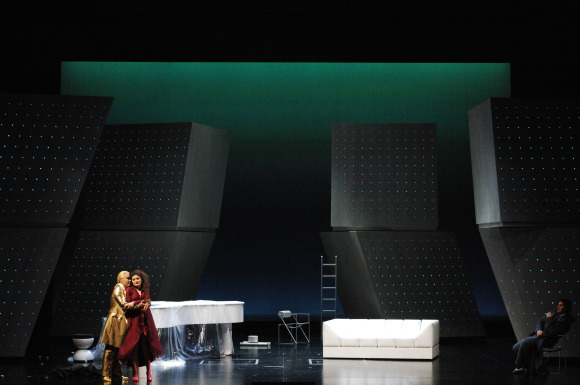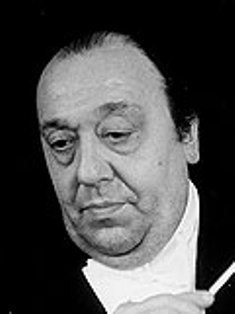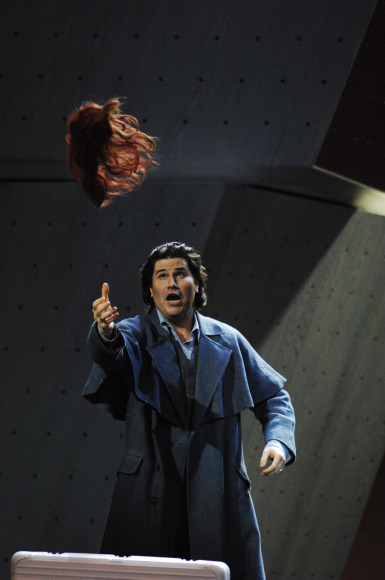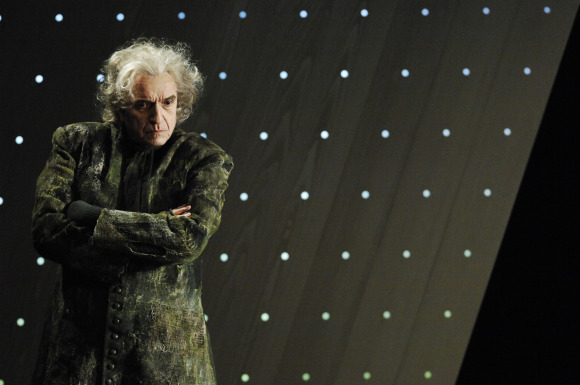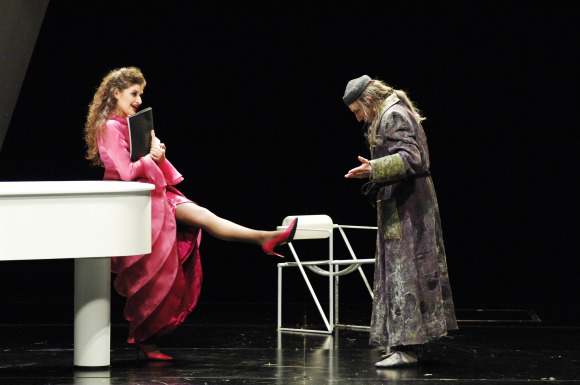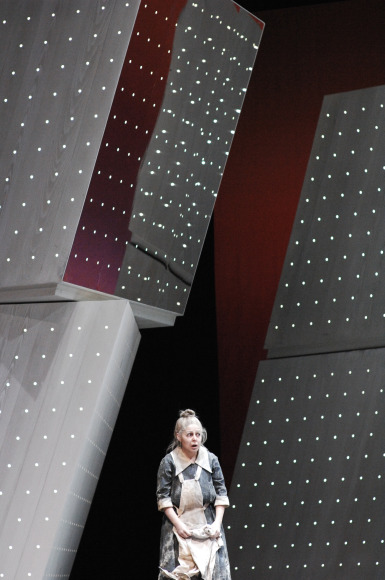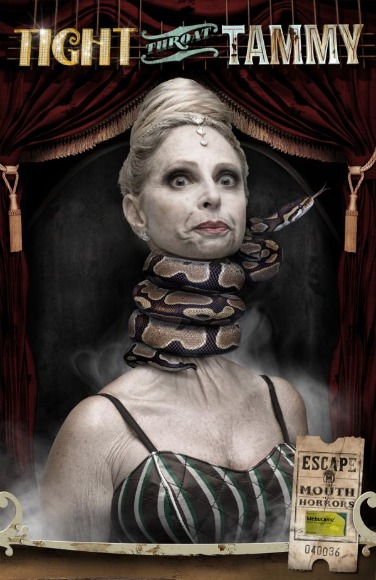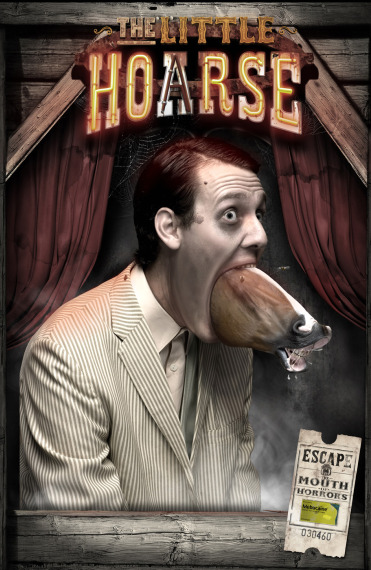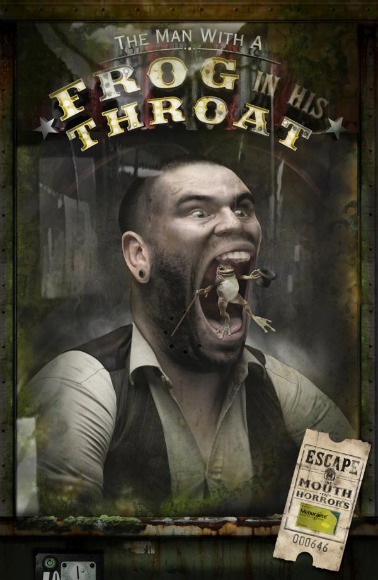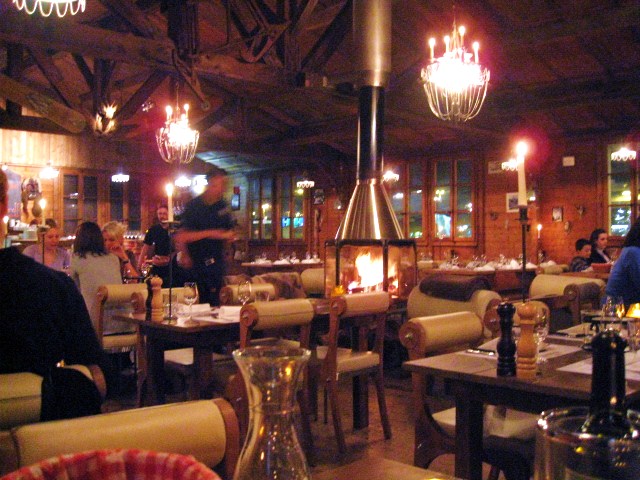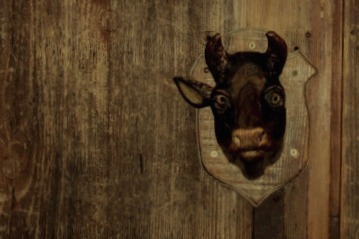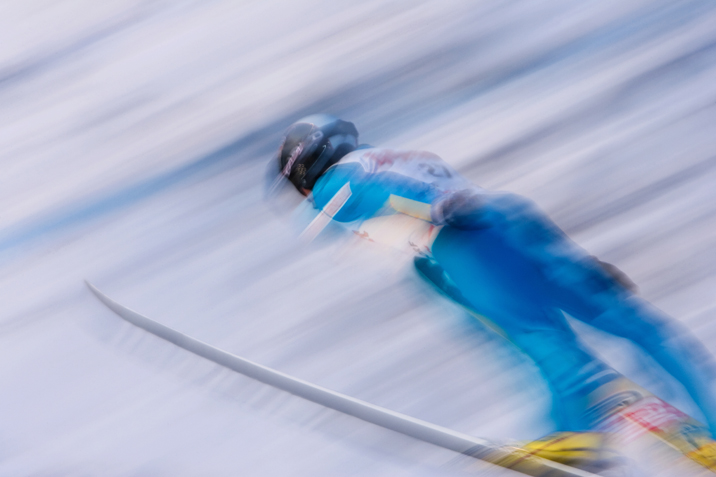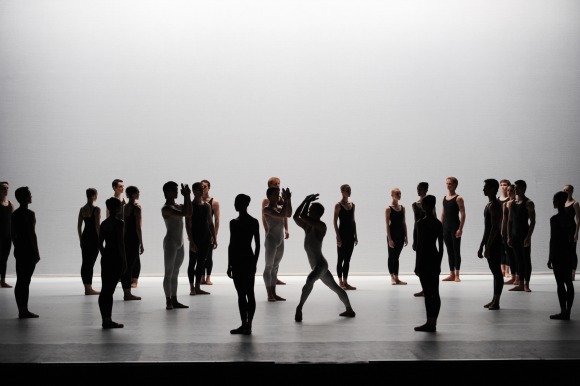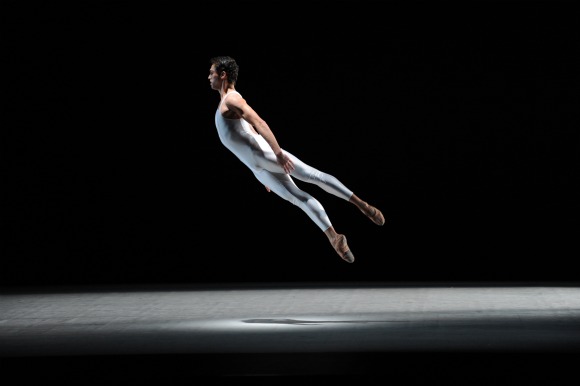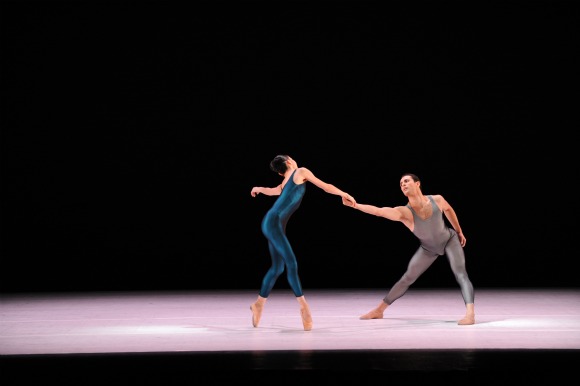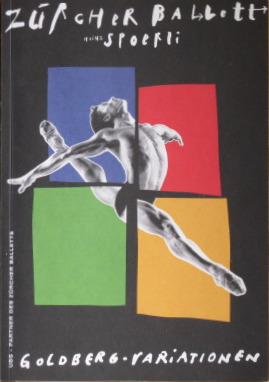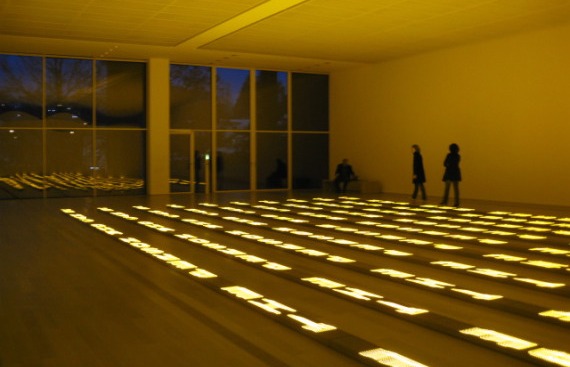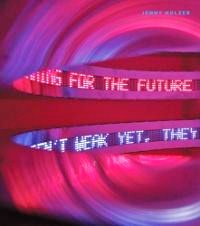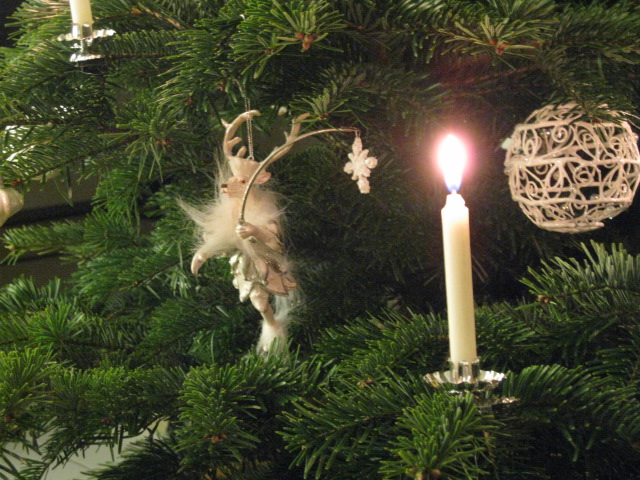It was 5 years ago when I saw the opera at the Opernhause Zurich for the first time. The ticket was given to me by one of the Opernhause support members. Quite often, members of such group or Opernhouse fans give away their tickets/seats to some acquaintances, for example, when they cannot make the performances due to travels, etc.
“Do you know Nello Santi? Even if this opera may bore you, I believe it still well worth seeing just Santi as the conductor.”
Right behind the orchestra pit. Center in the first row.
He had sort of supernatural appearance with dignity that I had never seen before. The big body slowly walked to the conductor’s podium from the wing of the stage. When he stood up there and turned around, a big roar of “Maestro!!” was heard and the sound of clapping hands echoed in the whole opera house. Santi’s face was right in front of me.
Born in 1931 in Italy, 78 years old. No adjectives such as old and mature will fit at all to describe him. He is one of the best contemporary conductors in the world, capable of creating strong, sensitive and lyrical music.
While he performed in Opernhause Zurich as a conductor in 1958 for the first time, even with the change of music directions as the time went by, Santi has been and still is the proud existence of this opera house. He regularly performs with NHK Symphony Orchestra in Japan.
The music Santi created and the ultimate aura he brought about became a magic to me, and I was unspeakably shocked that night.
This maestro Santi conducted “Il barbiere di Siviglia” by Gioachino Rossini, which was one of the most outstanding and talked-about operas this year at the Opernhause Zurich.
With the bold idea by Mr. Pereira, General Manager, for the “Il barbiere di Siviglia” this time, Italian star architest, Mario Botta from Ticino of Italian-speaking part of Switzerland, was in charge of the scenic art. The producer was shrewd Cesare Lievi. While it was a unique collaboration, it was a great production of performers with big name veteran singers as well as young able ones.
It was early 19th century in Siviglia, Spain.
The neighborhood factotum, barber Figaro succeeds in making the love bear fruit between the young beauty, confined in the house of the guardian doctor, and the count. Figaro somehow manages to come through by various witty ideas against conspiracies or sadistic and persistent interferences by the guardian, and the couple ends up being happily married finally. This is an opera buffa and well known as an ironic comedy.
Massimo Cavalletti, as Figaro showed a thorough bright star quality.
Doctor Bartolo who plotted a marriage after the money of Rosina who was a bird in a cage, was played by Carlos Chausson. Basilio, a music teach who courted him, was performed by Ruggero Raimondi who played a villain with real fierce expression. The singing and performances by these two great veterans sparked like oxidized silver and brought about certain dignity to this high-quality comedy by Rossini.
Lievi, the producer, says, “I have tried to express how this story is irrational. Life is irrational. The theme is love, and very special love.”
Count Almaviva, who tried to confirm the love of Rosina by lying about his identity, was played by Mario Zeffiri. He appeared in front of Rosina in ever-changing disguise, sometimes as a soliver, or a music teacher in other times and so on.
Lady Rosina was played by Serena Malfi of mezzo-soprano, who made her debut in this stage for the Opernhause Zurich. She was cute and smart contemporary young woman. She even went a head of the wisdom of Figaro trying to lead their love into fruition by fighting against the spite of the guardian. A bit whimsical but honest. She loved the Count Almaviva who was in disguise as a poor student.
Lievi continues, “Almaviva is in love. He enjoys fiction and loves amorous adventures. He loves possessing a woman. However, whether he really loves her or not, I don’t know.”
I heard that he consulted with the designer so that the costumes would be largely separated into 2 parts; for very old people and for the young.
Although this comedy was based on the conflict between generations and concepts of values, as well as those between aristocrats and commoners, it also tried to express the conflict by way of costumes.
Although it is assumed that the barber Figaro could have had lots of chances to achieve a successful career in that age judging from his sharp mind, his character showed that he was indifferent to such a matter. While he domonstrated light and easy performance and made us enjoy his singing with his active role, he had the coolest vision among all the characters. Favorable impressions of popular familiarity and artfulness owed a lot to the character of Cavalletti.
Also Rebeca Olvera, who played the role of the servant Berta who was always sneezing, enchanted us with her beautiful soprano aria. Even though she belonged to the “old people” with her old servant role, her skillful acting of easygoing stupid personality played a role of sophisticated spice in the whole story.
Well, the stage design by Mario Botta brought pros and cons for the audience as well as the media. I thought it was an audacious challenge and interesting, typically this opera house, however, the newspaper criticized quite harshly.
Botta says that the city of Zurich itself is an interesting target.
“Zurich is a very modern city with strong influence of contemporary art. While graphic art and modern art have brought various aesthetic consciousness to this town, we have brought ““Il barbiere di Siviglia” in the art world in the second part of the 20th century.”
Although he has designed the ballet stage of this opera house twice, it was his first time for an opera.
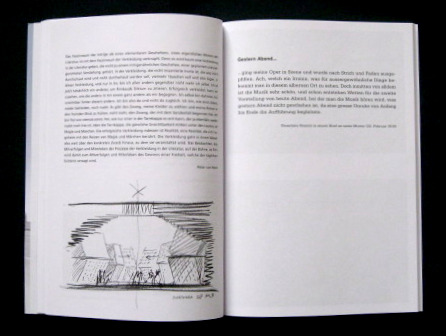
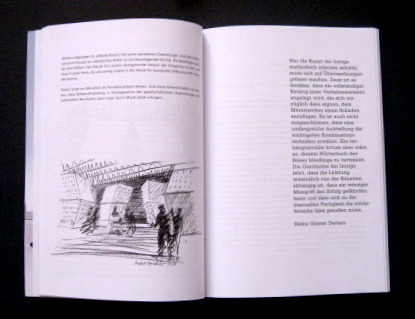
Four metal-grey double cubic moved around the stage as the story went on, by changing lights or showing movies or mirrors on the screen.
Also the trunk that the factotum barber Figaro carried was his shop itself that opened up anywhere. Scissors, wigs, the limb, or even a giraffe with somehow ever-extending neck appeared as well. The number 15 was written large, and it was assumed that the address wherever he opened up his shop was 15.
Somehow, I recalled the Japanese movie “Futen-no Tora.”
Let’s go back to the story of Botta.
“There is a huge difference between architecture and stage. Always unique spaces or places are created in architecture. Stages are totally different, and designing rooms is not the task. However, I must have the audience dream a dream. Performing the imagination of the audience is the major role.”
Curtain calls continued and Nello Santi also came up to the stage. I heard that he could play any musical instruments of the orchestra, and he played whispering cembalo this time.
“Rossini Crescendo” that Santi expressed turned out to be a poetic and elegant work where music expressed laughter, humor and irony, just like Rossini tailored this comedy of high quality.
The maestro bowed his head deeper than anybody else, and then slowly looked around the audience with a gentle smile.
Stage Photo: Opernhaus Zürich/ Suzanne Schwiertz
http://www.opernhaus.ch
Leave a Reply
A little while ago, when I was waiting for the tram, I felt some bizarre human figures behind my back.
In this city of Zurich, as you may encounter certain things or people far from the practical world, I thought it would be this sort of thing, and got on the tram without turning around.
My way back home. Now I saw those people from the window of my tram.
They seemed to have sore throats.
Tammy’s throat is tighten up by the snake and she lost her voice. Her friend talks in “hoarse voice” because “the little horse” is kicking inside his throat. Another friend has got a “frog in his throat” which makes his throat sore after all.
To fight against these wild beasts that bring such horrors, ordinary throat candies will not work.
“MEBUCAINE SORE THROAT REMEDY” is here to bring you peace to your throat.
Well, to demonstrate how powerful these drops are, let’s appeal its high efficacy with sharp visual impacts. The mode of expression is surreal anyway.
Love to see those people who have made such a decision.
This is a series of advertisement of Novartis, an international enterprise with its headquarters in Basel, Switzerland, who is also a topnotch leader in the pharmaceutical and biotechnology industry.
The campaign title is “Escape the Mouth Horrors.”
Brand : MEBUCAINE SORE THROAT REMEDY
Advertising Agency: Saatchi & Saatchi, Cape Town / Geneva
Executive Creative Director: John Pallant
Creative Director: Anton Crone
Art Director: Larissa Elliott
Copywriter: Alice Gnodde
Illustrator: Am I Collective
Photographer: Jillian Lochner
Leave a Reply
When a friend of mine from Japan visited here, I took her to one snobbish restaurant that the locals were talking about. Although I was sure it was a well-thought-out arrangement, she did not seem to be content at all unfortunately.
The reason she game me was, “Sure, it was delicious, but you can have this level of cuisine in Tokyo and Paris as well.”
As a matter of fact, it has been a trend for some time in European and North American restaurants in every city to serve fusion type of food, incorporating Asian or Japanese materials or tastes. Of course we can enjoy sophisticated surprises occasionally, however, quite often, they are not well incorporated or all look and taste more or less the same unless the original cooking ability is superb.
As she was a gourmet with lots of dining experiences than usual, I asked her again what sort of food she wanted to try. She responded, “I would like to see the caws. I would love to eat something that you can only eat in Switzerland.”
So the day after, we drove as far as some grassland where you could see cows, took some commemorative pictures with them, and went to the restaurant that was a remodeled cow-house to order fondue and homemade sausages. I heard that she bought a fondue set at the airport, and I was able to send her back home happily.
Fondue is a good way of entertaining when friends get together, since you do not have to spend too much time in your kitchen. In other words, it is a Swiss version of Japanese “Nabe” cuisine.
I am a bit embossed to say this since I am not a Swiss, but anybody can cook this easily. There are surprisingly many variations, and the combination of cheese or selection of liquors make your own house taste, which is quite interesting.
While homemade fondue is enjoyable, it is also fun for the season to have tasty fondue in a good restaurant.
While there are several fondue restaurants in the city, many “specialized” ones are open only during the fall and winter seasons. Of course if it is somewhat for tourists, or have general Swiss cuisine in the menu, fondue is often included, but that can be rather exceptional. The strictly “specialized” restaurants will be closed when the season is over.
Not to mention closing the restaurant, some fondue restaurants disappear without any trace. On the other hand, some appeared out of nowhere several years ago, and have become smash hits.
BARACCA ZERMAT
They have restaurants in Basel and Zurich, and the mountain lodge restaurant in the airport premises in Zurich is open from the end of November till the end of March. If you want to secure seats on weekends, you may have to make a reservation many weeks in advance.
The interior is done by Heinz Julen, artist from Zermat.
Having a “dream room” appearing in the city as the concept, everything time-slips to the heart-warming 1950s once you step inside.
Firewood logs are piled up around the mountain lodge and covered with snow.
Once you open the door with a cow’s head, you will see the rows of antique stake plates. Inside the room, logs are burning red in the big fireplace. On the wall you see a stuffed alpine ibex, a wild goat, and antlers of antelope, and old monochrome picture of Zermat.
What we ordered that night was called Motie-Motie, which was a typical Swiss fondue combining Vacherin cheese and rich Gruyeres cheese, half and half.
As tomato fondue and champagne and truffle fondue were well known in Switzerland, we tried their original named Baracca Fondue with fruits and bacon.
For the wine, we picked up Johannisberg from Valais Province where Zermat is located. While this white wine was fruity and rich, it was smooth and went very well with cheese. It had the label of Matterhorn, and sat there as a table wine.
The reason why Kirsch, which is cherry spirits, is used for fondue quite often is to help digestion. Therefore, instead of white wine, having fondue and drink Kirsch is another royal road. Although it is said to be good to your body, the alcohol content is over 40 degrees. So you’d better watch out.
Fondue is a very rustic cuisine, which is served in a pot that is used many times for a long time. Coldly simple tablewares and plastic wine coolers. The trick is when these simple factors are integrated and brought into a city, they look rather luxurious and sophisticated.
I must say that it is well designed so that you can have relaxed moments somehow by enjoying slow food, surrounding a big fire, in a mountain lodge literally like a barrack.
Poking a piece of bread in a skewer and turning it inside the pot, I was thinking this would be the last fondue of the season.
Unusually cold with heavy snow, this long winter is going away. This dream restaurant will be dismantled in a few weeks, and will disappear somewhere together with many stories that warmed up the people.
Spring is jus around the corner even in the Northern Europe.
http://www.baraccazermatt.ch
Leave a Reply
The time difference between Zurich and Vancouver is -10 hours. These days, some irregular events have been happening to my regular life. Looking at the TV programs has made our dinnertime vary slightly in the evenings.
Incidentally, when Swiss ski jumper, Simon Amann, who suddenly realized that he was a gifted jumper and was called “Harry Potter in the ski world,” won double gold medals, one Swiss TV station offered a special program of 1-hour interview with Hanspeter Gubelmann, President of Swiss Association for Sport Psychology (SASP) and Simon Amann’s sports psychologist.
Sports psychology is rather young as a study.
The earliest days of the study was seen in the United States in the latter half of the 19th century. Someone started to study among the children when he noticed that the children riding bicycles in a group demonstrated faster pace than those who were riding by themselves.
At the turn of the 20th century, Coleman Grifith started to study on the football and basketball players at the University of Illinois, and became interested in their reactions to the changes in perception, tenseness of muscles, relaxation and so on.
Although the study continued later on, it was from 1960s when the study was acknowledged in the academic field. First of all, The International Society of Sports Psychology was established in Rome, which activities lead the gradual dissemination throughout Europe. Almost at the same time, similar foundations were born in the United States, and the study of sports psychology established a new position in the study of psychology.
When the modern sports era arrived, starting with the welcome of sports psychologists in the international Olympic teams in 1984, any professional sports team these days has their own sports psychologists who are their special psychologists, supporting the athletes mentally. This has become a common sense in the world.
What is the work of a sports psychologist?
It might be a bit misleading, but it is not the idea that sports techniques can be improved by psychology. And, first of all, mind you that it is in the extreme opposite from the spiritual theories such as “guts” or “motivation” that are easy to understand but fossilized.
Life environments, individual characteristics, personal relationships, types of stress, and how to cope with fear and so on. Sports psychology is a new field of psychological study that will analyze the problems thtat individual athelet faces in various aspects, and try to solve such problems in order to bring out further possibilities. It will support athletes to be confident and able to control themselves calmly when participating in big competitions.
As this job requires continuous and extensive relationships with private lives of athletes, real partnership build on the relations of trust is the key.
In this sports psychology field, one big project is being developed in Switzerland, which is a plan to build a big-scale sports center within 3 years in the suburbs of Zurich. It will be a complex facility with 3 ice rinks, soccer stadium, together with doctors and functions of physiotherapy, bio mechanics and sports psychology. Sports Psychology Center will be established here and will play a role of core center in Switzerland in the future.
I had a chance to interview Ms. Cristina Baldssarre Ackermann, Vice Chairman of the bove mentioned Swiss Association for Sport Psychology. The photo was shot by Pirmin Rösli, a hot photographer who is active in various media such as German language newspaper NZZ(Neue Züricher Zeitung)in Europe and many other magazines.
March issue of the magazine “Precious” is now available at bookstores. Its opening gravure features this interview in the “Life is so Precious” section, introducing working women in the 4 large cities in the world.
http://web-precious.com
Leave a Reply
You can watch the CM at: http://vimeo.com/5065285
As this CM gives us the feelings of light and life, it might be a good idea to review it at this time of the year when things are gloomy.
Although the Swiss International Airline is currently under Lufthansa umbrella, it is still remains the face of Switzerland.
YOUR FLIGHT, SWISS MADE
Their mottos are “personal care,” “Swiss hospitality,” and “quality in every detail.”
This short film is the work of collaboration with Swiss film director, Marc Foster. Although it was created last year, the film is still being aired as a long run.
2 minutes and 27 seconds.
………………………………………………………………………………………….
Agency: Publicis Zurich
Creative: Martin Deneke
Director: Marc Forster
Producer: Peter Lehner
Director of Photography: Roberto Schaefer
Editor: Jay Nelson
Brand: Swiss Air
Production: Ping Pong Animation: MK12
Leave a Reply
While opera is, of course, famous when you talk about Zurich Opera House, the stage performances by the Zurich Ballet, which belongs to the House, is said to be “the most beautiful ballet in Europe” as a matter of fact.
As wonderful opera singers gather together in this small town, so do the ballet dancers. Selected elitests of the elite dancers in the world come together to this town, and perform like twinkling stars on the stage.
Heinz Spoerli, who is well known as a choreographer, used to be a dancer himself. He was appointed as the Artistic Director of Zurich Ballet in 1996, and since then he has been continuously creating innovative and unique productions.
Dancing the “Goldberg-Variationen” of Bach in all.
While this piece is best known for the performance by Glenn Gould, when 2 arias and 30 variations including the repeats are played, the performance will easily exceed 1 hour. The dances and short intervals of movements between dances make the performance of about 90 minutes. The pianist who continued to play throughout the performance without intermission was Alexy Botvinov. He was born in Odessa in Ukraine, and since he won the Rachmaninow-Competiton in Moscow when he ws 19, he has established his world reputation by winning the International Bach-Competitions and Schumann-Competition
If it is a solo concert like this time, all the more, and even if it is a ballet performance, lot of people come, being anxious to listen to his performance. Since playing Schumann for the ballet performance of “Szenen” in the mid-90’s, Odessa has been a good partner of Spoerli, creating excellent harmonies.
All the dancers of Zurich Ballet boast the level of elite performance and all capable of performing as soloists.
The expression of feelings by Yen Han, who receives overwhelming fan support, is delicate, deep and beautiful. His brathtaking perfect proportion brings such an enchanting elegance. Aliya Tanykpayeva is transferred from the Imperial Russian Ballet, while Sarah-Jane Brodbeck demonstrates cheerful, free and cute atmosphere.
Male dancers include Artur Babajanyan, Bryan Chan, Arman Grigoryan and so on. Each is the best and the brightest with the capabilities of super elevation, breathtaking motionlessness as well as talented agility.
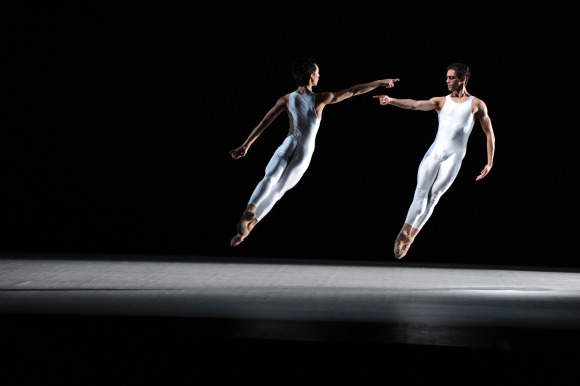
When the first aria started, many shadows started to move slowly. On the very dimly lit stage, each dancer seemed like to have become each sound, transmitting its own musical note.
No stage props. Simply Alexy Botvinov and one piano in the orchestra pit. Lighting, movements of the dancers, and the leotards that changed colors one after another. Instead of addition, deduction was the key here. Shaved off as much as possible, this piece of work seemed to bring about the inner face of each who was involved in this stage. Lights and shadows crossed each other.
Spoerli says, “For me, Goldberg-Variationen is my passing life itself.” Men and women meet, become enchanted each other and unite, and sometimes separation occurs. As you age, you become mature and change. As such, men and women get together then part from each other, as the time goes by.
The dancers, who danced through 30 variations of life, were sometimes elegant, lonely and sophisticated, and other times, they demonstrated such unpredictable surprising “dance” as if we were watching acrobatic gymnastics. Meticulously calculated varieties of exciting scenes appeared and disappeared in front of our eyes. Although there were soloests in the halfway, “pas de deux” was performed in the latter 3 pieces. They were so sophisticaated and flexible, just like dances in a dream.
The Goldberg-Variationen is “prelude” of the 16th variation, with comparison in the first half and the latter half. Spoerli choriographed it “as if forming into an arch.” In the scene when the first aria was repeated and it ended slowly, tranquility was brought back on the stage.
It was a long piece of music that even had an anecdote that it was performed due to insomnia. I was worried that I might fall a sleep, but was alert all throughout the performance by lots of surprises. Contrary to its highly evaluated production for many years, I heard “It’s just a performance with lots of changing colors of leotards and lights and lots of dancers come and go to dance. That’s all” by the regulars of Opera House. It was interesting to hear.
Omission that showed such enormous piece in a simple way just like that. It was assurance and sublimation of the basics of the classic. It reminded me that something like a cosmic view created by this ballet company has made Zurich Ballet very unusual.
Photo: Opernhaus Zürich / Peter Schnetz
http://www.opernhaus.ch
Leave a Reply
At the site of Jenny Holzer Exhibition at Fondation Beyel, somehow taking pictures is allowed, possibly a part of the intentional planning.Much talked about collaboration with the architecture by Renzo Piano. Other artists include Giacometti. Picasso, Max Ernst, and Andy Warhall who, for some period in his career, enjoyed outdoor advertising such as neon as his media for his expression. These are selected by Holzer herself, as a curator, from the collection of the Foundation. Here you may enjoy dialogues with these works of art.
http://www.beyeler.com
y1
Leave a Reply
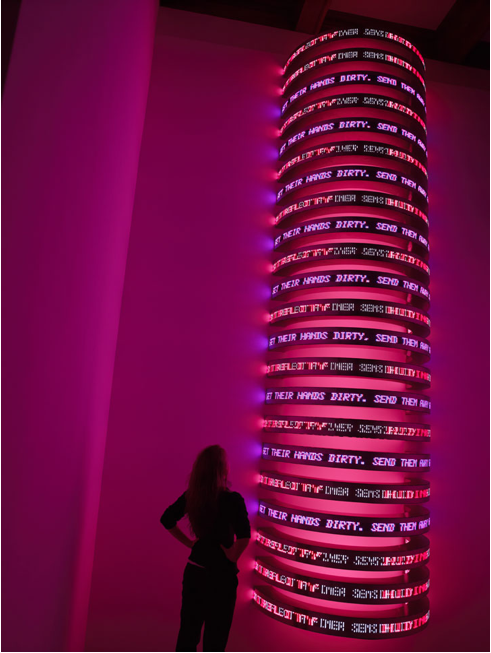
It is just less than 1-hour ride from Zurich to Basel by nonstop tain. While Basel is well known for its fairs of art or watches, it is an old city developed as the center for arts and science as well as culture, since the Medieval Ages. Sophisticated elegance is found in the Old Town or along the Rhein. The national train station of Basel is a station at the border with a neo-baroque façade. Germany, France and Switzerland all join its borders here.
We took the tram from the station to Riehn in the suburb. Although you can find many beautiful art museums in the world, at this Fondation Beyeler, situated by a big pond with abundant water, the tranquility and elegance welcome the minds of visitors who come here to appreciate art.
Work by the world’s well-known architect, Renzo Piano
Not to mention that Beyeler has wonderful and carefully selected collections, it is known as a museum that hold very high-quality exhibitions in Europe. At the site of the Basel Art Fair every year, this is the art museum where you always find on your right from the entrance, as the very first booth.
Jenny Holzer Exhibition is being held over the New Year. While there is no need to refresh your memory, she is one of the most prominent contemporary artists today. She won the Golden Lion award in the Venice Biennale in 1990, and since this recognition, she has developed her creative activities which conveys, like abundant waves, her words of strong social and political but still poetic nature into a wider field.
She was born in Ohio, USA in 1950. Her recent projects have often involved cties around the world, being used as medea, such as sending phrases on electric LED bulletin boards. The exhibition this time in Zurich demonstrated her work on the wall on the hill of Lindenh that looked down the Limmat River in the Old Town. In Basel, her messages were kept running through the cathedral, inside the SBB station, City Hall, or on stone pavements and on the bronze Virgin Mary in the church.
g_FB_holzer-jpg
© 2009 Jenny Holzer, member Artists Rights Society (ARS), New York Photo: Serge Hasenböhler
The exhibition consists of the texts in the late ‘70s and major works in all the fields she has been involved since the late ‘80s. Especially, it focuses on her recent works including those that have not yet been published in Europe. It is a large-scale show for the first time in Switzerland, introducing paintings, objects as well as LED installations.
Furthermore, this is for the special and flexible courtesy of Beyeler that they have selected, from their collections, the works of A. Giacometti. P. Picasso, K. Malevich, and F. Bacon, so that the viewers can also encounter totally different types of art, in terms of interaction with the works of Holzer, while they move from one installation to another or at the same time of viewing the works of Holzer.
The exhibition will be open until January 24, 2010.
http://www.beyeler.com/
Leave a Reply
013a1
Alpine Mountains were asleep in the color of silver.
Although it snowed at midnight on the New Year’s Day, all melted in the following day and it brought a brilliant blue sky for the first three days of the year.
New Year’s Eve. All the churches in this neighborhood rang their bells all at once, and fireworks shot in the sky one after another in the opposite side of the lake. We could hear the cheers from the far distance.
The top of the champagne bottle that was supposed to be opened for the New Year’s Eve Countdown, was quite stubborn, but finally opened by the force of a nut cracker, just in time for the midnight. The TV was showing the live street views of Zurich. Various faces from Africa, Eastern Europe, or South America as well as the local Swiss youth, were smiling at the TV screen.
The fireworks set pieces, which were to be developed in full scale at around 300 meters from the ground, were quite artistic and displayed interesting performances this year. They erupted from the lake, kept running up and ended up with dancing in the space. Fantastic glow like aurora, appeared in the darkness and covered the surface of the water.
In the bright light, lovers embraced each other, kissed each other time to time, and looked up the night sky again.
New Year has come!
We all wish for a peaceful year.
Leave a Reply
A fir tree arrived from the further north of Northern Europe.
In the German-speaking world, there is a custom to decorate the tree on the morning of the 24th.
When farmiliar faces get together, the presents under the fur tree pile up higher.
Sooner or later, someone will light the candle one by one.
Father telling a Christmas story to his children. Music scores of the hymns. Sound of an organ.
Although this scene of the night will change little by little every year,
While it is peaceful, you feel some solemnness in the air.
Merry Christmas!!
Wishing you all a wonderful night.
